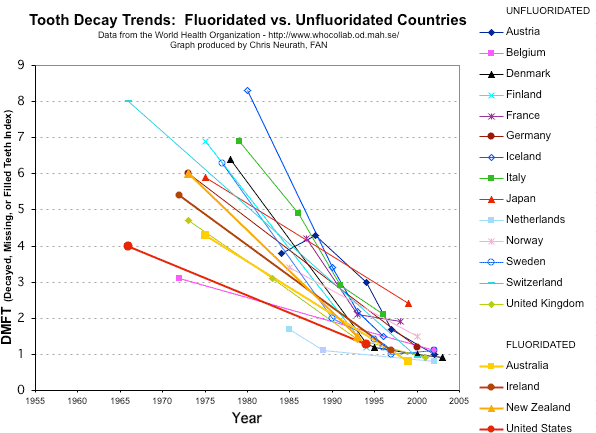Fluoridation is Not effective in reducing tooth decay.
Tooth decay declined more in many non-fluoridated developed countries that in the US.
|
DMFT (Decayed, Missing & Filled teeth) Status for 12 year olds by Country
- World Health Organization Data (2004) - |
|||
|
Country
|
DMFTs
|
Year
|
Status*
|
| Germany |
0.7
|
2005
|
No water fluoridation, but salt fluoridation is common |
| Australia |
0.8
|
1999
|
More than 50% of water is fluoridated; no salt fluoridation |
|
Denmark
|
0.8
|
2006
|
No water fluoridation or salt fluoridation |
|
Netherlands
|
0.8
|
2002
|
No water fluoridation or salt fluoridation
|
|
Zurich, Switzerland
|
0.9
|
2000
|
No water fluoridation, but salt fluoridation is common
|
|
UK (England & Wales)
|
0.9
|
2000
|
11% of water supplies are fluoridated; no salt fluoridation
|
|
Austria
|
1.0
|
2002
|
No water fluoridation, but salt fluoridation is available to a limited extent. |
|
Sweden
|
1.0
|
2005
|
No water fluoridation or salt fluoridation
|
| Italy |
1.1
|
2004
|
No water fluoridation or salt fluoridation |
|
Belgium
|
1.1
|
2002
|
No water fluoridation or salt fluoridation |
|
Ireland
|
1.1
|
1997
|
More than 50% of water is fluoridated; no salt fluoridation
|
|
Finland
|
1.2
|
2006
|
No water fluoridation or salt fluoridation
|
|
US
|
1.28
|
1992-1994
|
More than 50% of water is fluoridated; no salt fluoridation
|
| Iceland |
1.4
|
2005
|
No water fluoridation or salt fluoridation
|
| New Zealand |
1.7
|
2005
|
More than 50% of water is fluoridated; no salt fluoridation |
|
Norway
|
1.7
|
2004
|
No water fluoridation or salt fluoridation
|
|
France
|
1.9
|
1998
|
No water fluoridation, but salt fluoridation is common
|
| Data from WHO Oral Health Country/Area Profile Programme Department of Noncommunicable Diseases Surveillance/Oral Health WHO Collaborating Centre, Malmö University, Sweden http://www.whocollab.od.mah.se/euro.html | |||
